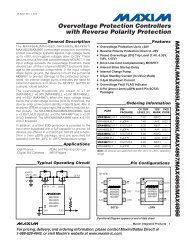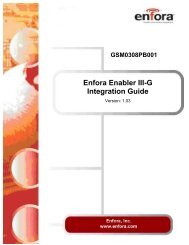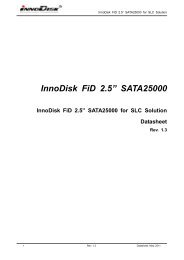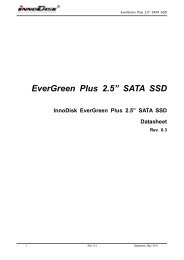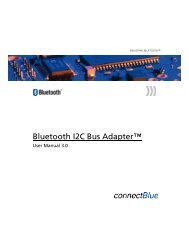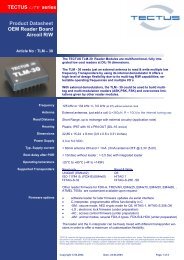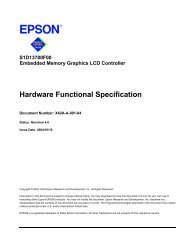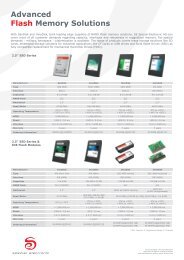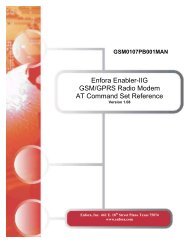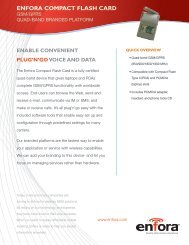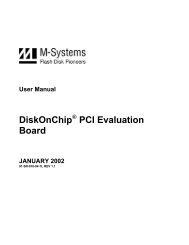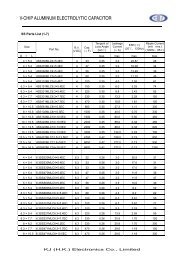AT+i Programmer's Manual - SE Spezial-Electronic AG
AT+i Programmer's Manual - SE Spezial-Electronic AG
AT+i Programmer's Manual - SE Spezial-Electronic AG
Create successful ePaper yourself
Turn your PDF publications into a flip-book with our unique Google optimized e-Paper software.
<strong>AT+i</strong> Command Set<br />
If a syntax error is found anywhere in a command line, the remainder of the line is<br />
ignored and the I/ERROR result code returned.<br />
An <strong>AT+i</strong> command is accepted by iChip once the previous command has been fully<br />
executed, which is normally indicated by the return of an appropriate result code.<br />
1.4 Escape Code Sequence<br />
While the iChip is in Internet mode attending to Internet communications, it is possible to<br />
break into the communications and abort the Internet mode in an orderly manner. This is<br />
achieved by sending the iChip a sequence of three (+) ASCII characters (+++) after a half<br />
second silence period. In response to this, the iChip:<br />
Shuts down Internet communications.<br />
Terminates data transmission to the host.<br />
Performs a software reset.<br />
Responds with an I/ERROR (056) message.<br />
Returns to command mode.<br />
A maximum delay of 10msec may elapse from the time the (+++) escape sequence is sent<br />
until iChip cuts off transmission to the host. The interrupted Internet activity is not<br />
completed. Nevertheless, this is considered to comprise a session. Thus, parameters set<br />
with the (~) character are restored to their permanent value.<br />
1.5 Socket Command Abort<br />
While the iChip is in Internet mode, during a TCP or UDP socket operation, it is possible<br />
to override iChip‘s normal timeout procedure and abort the current socket operation in an<br />
orderly manner. This is achieved by sending the iChip a sequence of three ASCII (-)<br />
characters (---) following a half second silence period. The socket commands to which<br />
this applies are: STCP, SUDP, SSND, and SFSH. When iChip detects the socket abort<br />
command, it aborts the last socket command and returns an I/ERROR following the<br />
STCP and SUDP commands, or I/OK during an SSND or SFSH command.<br />
1.6 Auto Baud Rate Detection<br />
iChip supports auto baud rate detection on the host serial communications line. After<br />
power-up, iChip enters auto baud mode when the BDRF parameter is set to the value ‗a‘.<br />
The <strong>AT+i</strong>BDRA command forces iChip into auto baud mode while it is already in<br />
operation.<br />
In auto baud mode, iChip expects an A or a character. This is usually the first character<br />
sent, since in command mode a meaningful command is always prefixed by <strong>AT+i</strong>.<br />
The host may send an a or A to the iChip to allow it to determine the host‘s baud rate. It<br />
may also send a complete <strong>AT+i</strong> command. In any case, iChip detects the A or a character,<br />
determines the correct baud rate, and configures its serial channel during the stop bit.<br />
Thus, the next character is received by the serial port at the correct baud rate. The A itself<br />
is retained as well. iChip supports auto baud rate detection for the following baud rates:<br />
2400, 4800, 9600, 19200, 38400, 57600, and 115200.<br />
<strong>AT+i</strong> Programmer‘s <strong>Manual</strong> Version 8.21 1-2



